Journey into the enigmatic world of the Perizzites in the Bible, where mystery and history converge to reveal ancient tales untold.
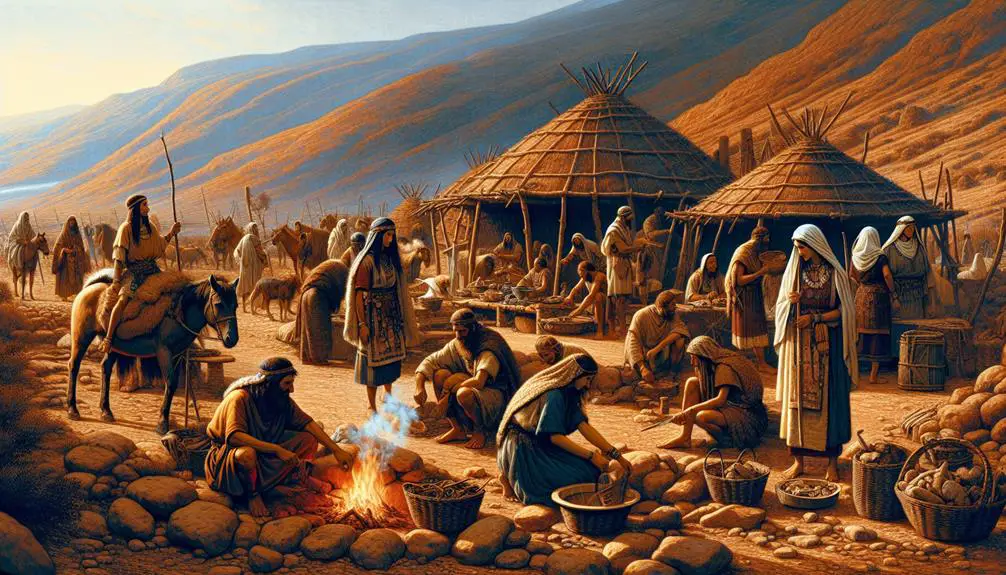
Perizzites in the Bible
Just as a single brushstroke can hint at the artist's broader vision, the mention of the Perizzites in biblical texts offers a glimpse into the complex tapestry of ancient Near Eastern cultures.
You've likely encountered their name amidst stories of conquest and covenant, nestled between tales of giants and battles, yet the Perizzites remain shrouded in mystery. Their interactions with the Israelites, cultural practices, and eventual disappearance from historical records invite you to uncover more about these enigmatic people.
This exploration promises not just answers, but a deeper understanding of the biblical narrative's interwoven communities.
Key Takeaways
- The Perizzites were an ancient people with uncertain origins, living in the Canaanite regions of modern-day Israel and Palestine.
- Biblical narratives often mention the Perizzites in the context of land inheritance promises and conflicts with the Israelites.
- Their culture likely included agricultural practices, polytheistic worship, and artistic expressions through pottery.
- Archaeological discoveries provide insights into their decline, attributed to factors like assimilation, conquest, and environmental changes.
Historical Background of the Perizzites
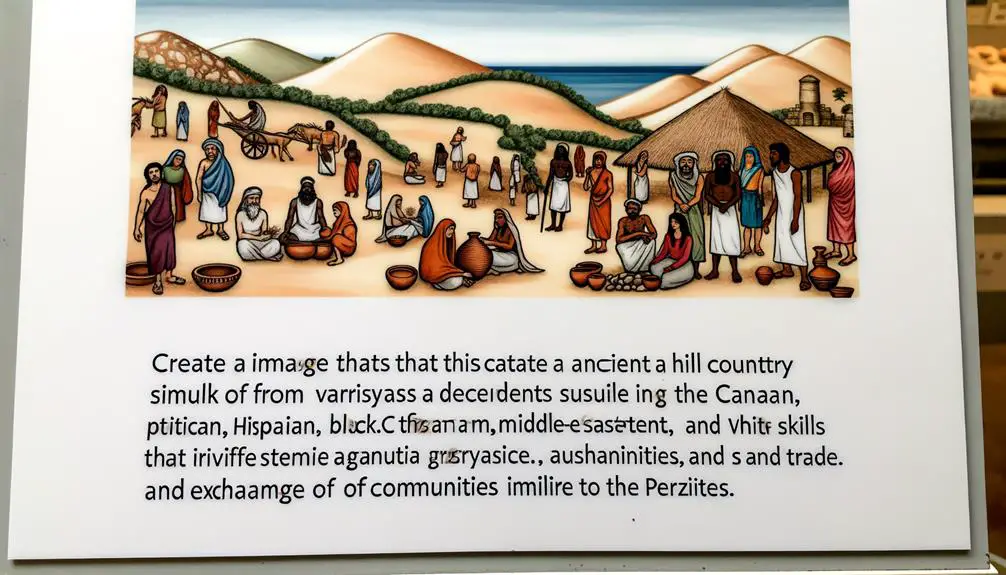
Tracing back to the ancient Near East, the Perizzites were a group whose presence and interactions are intricately woven into the fabric of early biblical history. You might find yourself pondering over who they were and how they fit into the larger historical and biblical narratives. Origin theories concerning the Perizzites vary, with some scholars proposing that they were a nomadic group, while others suggest they were perhaps more sedentary, engaged in agricultural activities. This ambiguity stems from the etymological roots of their name, which might hint at a lifestyle lived in villages or open country, contrasting with urban centers.
The geographical distribution of the Perizzites adds another layer of complexity to their story. Historically, they're thought to have occupied regions that are now parts of modern-day Israel and Palestine, intermingling and sometimes conflicting with the Canaanites and other ancient peoples. Their spread across such a vast area suggests that the Perizzites weren't confined to a single, homogenous group but were likely diverse in their cultural practices and societal structures.
Analyzing these origin theories and the geographical distribution of the Perizzites, it's clear that their history isn't straightforward. They were a people who adapted to and influenced their surroundings, contributing to the rich tapestry of the ancient Near East. As you delve deeper into their story, keep in mind the scholarly debates and archaeological findings that continue to shape our understanding of the Perizzites' role in biblical and historical narratives.
Biblical References and Mentions
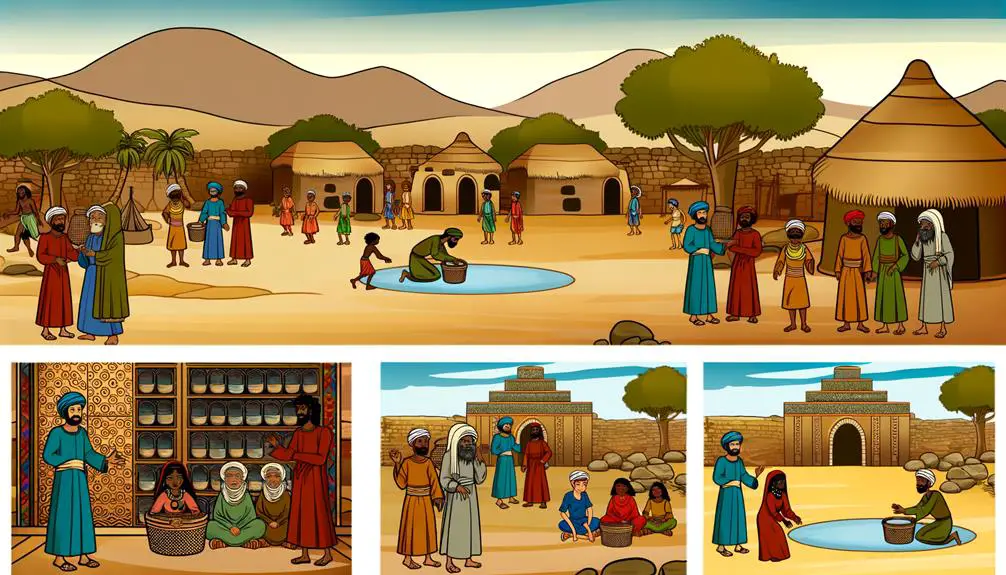
The Bible's narrative intricately weaves the Perizzites into its historical tapestry, presenting them in various contexts that reveal their interactions with other ancient groups. As you delve into the biblical references and mentions of the Perizzites, you'll uncover insights into their genealogical origins and geographic distribution, which are pivotal in understanding their role and significance within the biblical world.
- Genealogical Origins: The Bible doesn't provide a clear lineage for the Perizzites, contrasting them with other groups whose ancestries are meticulously documented. This absence suggests that the Perizzites might've been recognized more for their geographic presence than a distinct lineage, making their origins a subject of scholarly speculation.
- Geographic Distribution: Scripture pinpoints the Perizzites primarily in the Canaanite region, indicating their widespread settlement across various territories. This distribution suggests a non-centralized group, spread out in villages and rural areas rather than unified under a single political entity.
- Biblical Encounters: The narratives recount interactions between the Perizzites and Israelites, notably during the conquests of Canaan. These encounters often highlight the Perizzites alongside other Canaanite groups, facing the Israelite incursions.
- Covenant Context: In promises and covenants, God frequently lists the Perizzites among the nations that the Israelites would displace from Canaan. This inclusion serves not only as a reminder of the divine promise but also underscores the Perizzites' significance within the land that was to be inherited.
In analyzing these aspects, you gain a more nuanced understanding of the Perizzites' presence and role within the biblical narrative, framed by their uncertain genealogical origins and their broad geographic spread across the Canaanite landscape.
Cultural and Religious Practices
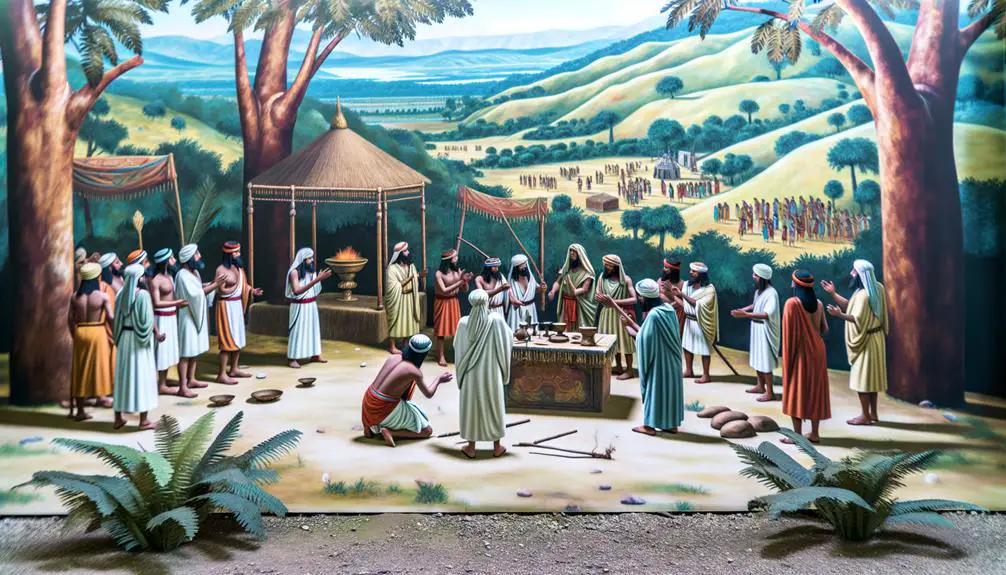
While specific details remain sparse, examining the cultural and religious practices of the Perizzites reveals a complex tapestry of beliefs and rituals that intersected with their neighboring civilizations. The Perizzite diet, an essential aspect of their culture, likely consisted of agricultural products, as evidenced by the fertile lands they inhabited. This diet might've included grains, fruits, and vegetables, providing a foundation for their societal structure and daily routines. Additionally, animal husbandry could have played a role, though the extent of this practice remains unclear due to limited archaeological evidence.
Artistic expressions among the Perizzites, though not extensively documented, likely served as a significant aspect of their cultural identity. Pottery, one of the few remnants from this period, offers insight into their artistic endeavors. The styles and motifs found on these artifacts suggest a society that valued aesthetic representation, possibly incorporating religious symbolism into their designs. Such expressions would haven't only served utilitarian purposes but also acted as mediums for religious and cultural narratives, reinforcing communal beliefs and values.
The religious practices of the Perizzites, while not fully understood, appear to have been polytheistic, similar to other Canaanite groups. Worship likely centered around nature deities and fertility gods, reflecting an agricultural society's dependence on the natural world. Rituals and ceremonies, therefore, would have been closely tied to the agricultural calendar, marking significant seasonal changes and agricultural milestones.
Interactions With the Israelites
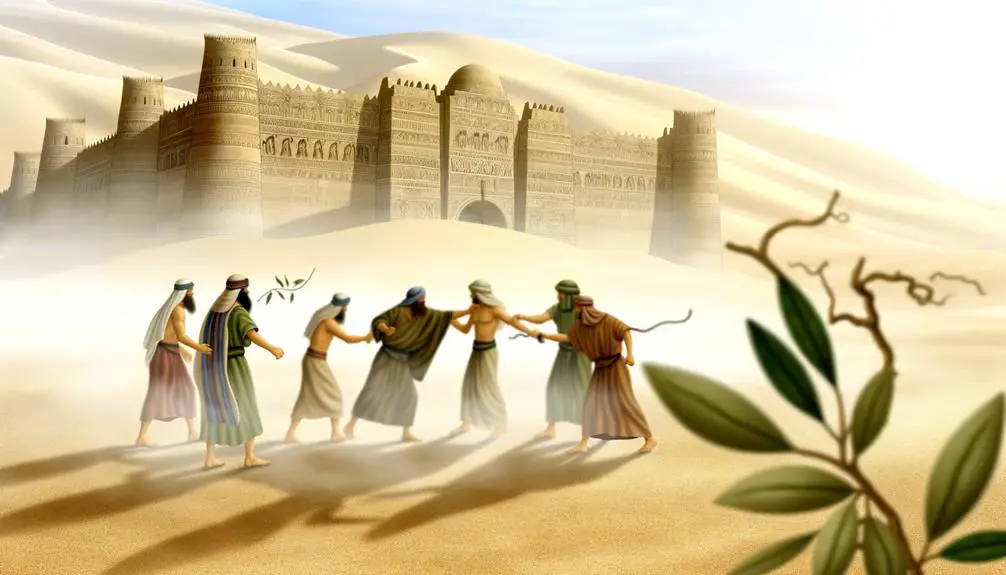
You must consider the historical context of the Perizzites' interactions with the Israelites, marked by initial conquest attempts, covenant land conflicts, and the significant impact of divine commands. These elements highlight the complex relationship between the two groups, framing it within the broader narrative of territorial and religious struggle in ancient times.
Understanding these points sheds light on the multifaceted nature of their encounters and the enduring implications for both communities.
Initial Conquest Attempts
Israel's initial attempts to conquer the Perizzites reflect a complex interplay of military strategy, divine intervention, and the socio-political landscape of the ancient Near East. These attempts were marked by failed sieges, highlighting the robust defenses of the Perizzites.
Innovative military strategies were employed by the Israelites, albeit with varying degrees of success. The pivotal role of divine intervention as narrated influenced the outcomes of battles.
Additionally, the adaptation to the socio-political dynamics of the region was crucial, as it often dictated alliances and enmities. This phase in Israelite history underscores not just the physical battles fought, but also the spiritual and political dimensions that influenced these endeavors.
The attempts to subdue the Perizzites set the stage for the unfolding narrative of conquest and settlement in the Promised Land.
Covenant Land Conflicts
Building on the initial conquest attempts, the conflicts over covenant land between the Perizzites and the Israelites further illuminate the intricate relationship between divine promises and human action in biblical narratives. These encounters showcase a spectrum of human responses to divine directives, mirrored in modern parallels where territorial disputes often lead to peace negotiations or prolonged conflict.
Biblical Narrative |
Modern Parallels |
|---|---|
Land allocation |
Territorial claims |
Divine promises |
Ideological beliefs |
Conflict |
Diplomatic tensions |
Peace negotiations |
International mediation |
Human action |
Political maneuvers |
This table underscores the timeless nature of land conflicts and the pursuit of peace, drawing a clear line from the biblical episodes involving the Perizzites and the Israelites to today's international disputes. The covenant land conflicts serve as a reminder of the complexities surrounding the interplay of faith, identity, and politics.
Divine Commands Impact
The influence of divine commands on the interactions between the Israelites and the Perizzites significantly shaped the course of their historical conflicts and resolutions. This complex relationship, viewed through modern interpretations, reveals intriguing ethical considerations.
- Divine instructions often guided the Israelites' approach, impacting decisions on war and peace.
- Ethical considerations emerged from divine commands, challenging the Israelites to balance justice with mercy.
- Modern interpretations of these narratives invite debates on morality, emphasizing context and divine intent.
- The historical context of these interactions provides insights into ancient societal norms and the role of divine directive in shaping ethical frameworks.
This analysis highlights the multifaceted impact of divine commands, underscoring their significance in historical conflicts and ethical deliberations within biblical narratives.
Archaeological Evidence and Insights

You'll find that archaeological findings play a crucial role in understanding the Perizzites' presence and culture in ancient times. Discoveries of Perizzite settlements and the analysis of cultural artifacts have provided tangible evidence of their existence and way of life.
These insights help bridge the gap between biblical texts and historical reality, offering a more nuanced view of this ancient people.
Perizzite Settlement Discoveries
Archaeological endeavors have unearthed evidence suggesting that Perizzite settlements, once thought to be mere biblical allegories, did indeed exist across ancient landscapes. By analyzing settlement patterns and applying varied excavation methodologies, researchers have gained profound insights into the Perizzite way of life.
- Settlement patterns reveal a preference for hilly regions, offering strategic advantages and fertile lands.
- Excavation methodologies have evolved, incorporating technological advancements to detect sub-surface remains.
- Geographical distribution indicates a widespread presence, challenging previous notions of their limited influence.
- Construction techniques unearthed suggest a blend of innovation and adaptation to environmental constraints.
This discovery not only enriches our understanding of ancient societies but also highlights the intricate relationship between biblical texts and historical realities.
Cultural Artifacts Analysis
Delving into the cultural artifacts unearthed from Perizzite settlements offers invaluable insights into their societal norms and daily practices. Through meticulous artifact restoration, researchers have pieced together fragments of pottery, tools, and religious items, revealing a complex society deeply intertwined with its environment and religious beliefs.
These artifacts, when juxtaposed with modern comparisons, highlight not only the technological advancements of the Perizzites but also their artistic expressions and communal values. The detailed analysis of these items, ranging from everyday utensils to ceremonial objects, underscores the Perizzites' skill in crafting and their societal organization.
This scholarly examination, grounded in objective methodology, enriches our understanding of ancient cultures, bridging the past and present through the tangible remnants left behind.
The Perizzites' Decline and Disappearance

Despite numerous references throughout ancient texts, the exact reasons behind the Perizzites' decline and eventual disappearance remain largely speculative, yet several historical and biblical factors offer plausible explanations. Modern interpretations and genetic studies have begun to shed light on this mystery, suggesting a combination of factors that contributed to their fading presence in historical records.
- Assimilation with Neighboring Tribes: Over time, the Perizzites likely merged with other Canaanite tribes and groups, losing their distinct identity in the process. This assimilation would have diluted their unique cultural and societal structures, making them indistinguishable from their neighbors.
- Conquest and Displacement: Biblical accounts suggest that the Perizzites, along with other Canaanite peoples, faced numerous military campaigns from the Israelites. These conflicts could have led to significant population declines and displacement, further contributing to their disappearance.
- Ecological and Environmental Changes: Shifts in climate and natural disasters might've played a role in disrupting the Perizzites' way of life, especially if their agriculture or settlements were particularly vulnerable.
- Disease and Famine: Like many ancient populations, the Perizzites could have been affected by diseases and famines. Without the means to combat these crises effectively, these events could have drastically reduced their numbers.
Significance in Biblical Narrative

The Perizzites play a crucial role in the biblical narrative, serving as a backdrop against which the Israelites' journey and conquests are vividly portrayed. Their presence and interactions with the Israelites not only highlight the challenges faced but also underscore the divine promise of land that was central to Israelite identity. Perizzite origins, though somewhat shrouded in mystery, are often linked to the broader context of Canaanite societies, offering insights into the complex tapestry of ancient Near Eastern cultures. This connection provides a richer understanding of the socio-political and religious landscape that the Israelites navigated.
Modern interpretations of the Perizzites' significance in the biblical narrative emphasize their role as part of a collective challenge to Israelite settlement and sovereignty. Scholars suggest that the mention of Perizzites alongside other groups serves to symbolize the diversity of the inhabitants of Canaan, highlighting the formidable task of conquest and settlement faced by the Israelites. This perspective underscores the narrative's function as a means to illustrate moral and theological lessons, particularly concerning faith, obedience, and the fulfillment of divine promises.
Furthermore, the evolving scholarly discourse on the Perizzites invites a reconsideration of their historical and cultural impact. It prompts questions about the accuracy of their portrayal and the extent to which these narratives reflect historical realities versus theological or ideological motivations. Thus, the study of the Perizzites not only enriches our understanding of ancient Israelite history but also contributes to ongoing discussions regarding the interpretation of biblical texts in light of archaeological and historical research.
Frequently Asked Questions
How Do Modern Historians and Theologians Reconcile the Moral and Ethical Implications of the Israelites' Conquest of the Perizzites as Described in the Bible?
You're delving into how modern historians and theologians tackle the moral quandaries surrounding ancient conquests.
They often lean on ethical relativism, understanding actions within their historical context. This perspective doesn't excuse behaviors but seeks to comprehend decisions based on the time's ethics.
Are There Any Contemporary Communities or Groups That Claim Descent or Cultural Heritage From the Perizzites?
In your quest to explore ancient legacies, you're diving into whether there are groups today claiming roots from the elusive Perizzite descendants. Unfortunately, the trail's cold; there's no contemporary community openly identifying with Perizzite heritage or actively engaged in their cultural preservation.
This absence might reflect historical assimilation or the complexities of tracing such ancient lineages directly. It's a fascinating puzzle, blending history with the mysteries of cultural continuity and identity.
How Have Artistic and Literary Representations of the Perizzites Evolved From Ancient Times to the Modern Era?
Exploring the evolution of Perizzite representations, you'll find that ancient inscriptions and pottery initially offered a limited, often fragmented view.
Over centuries, artistic and literary interpretations expanded, blending historical research with creative liberty. This evolution reflects a scholarly endeavor to understand and reimagine Perizzite culture.
Modern portrayals often juxtapose ancient artifacts with contemporary insights, offering a nuanced perspective that diverges significantly from early, simplistic depictions rooted in archaeological findings.
What Are the Major Theological Debates or Interpretations Regarding the Perizzites' Role and Portrayal in the Bible Within Different Christian Denominations or Other Religions?
Navigating the major theological debates or interpretations about their role and portrayal is like sailing through a sea of diverse opinions. Different Christian denominations and other religions delve into the Perizzite origins and Biblical symbolism, dissecting their significance.
You'll find that views vary widely, reflecting a spectrum from historical curiosity to symbolic interpretation. Analytically speaking, understanding their portrayal demands a deep dive into theological perspectives, enriching your grasp of Biblical narratives.
How Has the Understanding of the Perizzites' Language, if Any Records or Assumptions Exist, Contributed to the Study of Ancient Near Eastern Languages and Cultures?
You're diving into how linguistic methodologies shed light on ancient Near Eastern cultures, specifically through the study of the Perizzites' language.
While direct records are scarce, assumptions based on linguistic analysis contribute significantly.
This approach unveils patterns of cultural assimilation, highlighting how these communities influenced and were influenced by their neighbors.
Understanding their language offers a unique lens into the complex tapestry of ancient interactions, enriching our grasp of historical dynamics.
Conclusion
In conclusion, the Perizzites, a group veiled in the mists of ancient history, play a crucial role in the biblical narrative. Despite the scarcity of archaeological evidence, their interactions with the Israelites highlight the complex dynamics of ancient Near Eastern societies.
As shadows in the archaeological record, their cultural and religious practices remain largely speculative. Yet, their story serves as a vital thread in the tapestry of biblical history, illustrating the ebb and flow of civilizations long gone.



Sign up